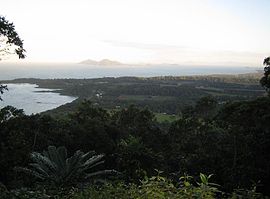Mission Beach, Queensland
|
Mission Beach Queensland |
|||||||||||||
|---|---|---|---|---|---|---|---|---|---|---|---|---|---|

Mission Beach
|
|||||||||||||
| Coordinates | 17°52′10″S 146°06′25″E / 17.86944°S 146.10694°ECoordinates: 17°52′10″S 146°06′25″E / 17.86944°S 146.10694°E | ||||||||||||
| Population | 765 (2011 census) | ||||||||||||
| Established | 1914 | ||||||||||||
| Postcode(s) | 4852 | ||||||||||||
| Elevation | 10 m (33 ft) | ||||||||||||
| Location |
|
||||||||||||
| LGA(s) | Cassowary Coast Region | ||||||||||||
| State electorate(s) | Hinchinbrook | ||||||||||||
| Federal Division(s) | Kennedy | ||||||||||||
|
|||||||||||||
Mission Beach is a small town and locality in the Cassowary Coast Region, Queensland, Australia. In the 2011 census, Mission Beach had a population of 765 people.
Mission Beach is bounded on the east by the Coral Sea. The popular tourist destination of Dunk Island lies 4 kilometres (2.5 mi) offshore.
Today, what were once separate villages have now grown such that they are considered one town, Mission Beach. The villages are, from south to north, South Mission Beach, Wongaling Beach, Mission Beach, Bingil Bay, Brooks Beach and Carmoo. Development has also begun at Garners Beach to the north.
In 1872 it was alleged by two sailors (Wilson and Sullivan), that the captain (Stratman) and some of the crew of the ill-fated Maria which was wrecked in a "typhoon", were killed and eaten by natives north of Tam O'Shanter Point. Survivor Thomas Ingham attests that the aborigines were initially friendly with his party until joined by another group of unfriendly natives. A group of vigilantes raided the area now called South Mission Beach and attacked a local aboriginal camp. In 1916 Ingham wrote : "Sub-Inspector Johnstone gave short-shrift to the cannibals, who had eaten the captains party, and the brutes who had speared me and taken my belt was seen to be wearing it around his head like a crown. That sealed his fate. This belt saved my life when I gave it to him. It made him a king when he crowned himself with it and bought about his demise. Sub-Inspector Johnstone gave it back to me, and I have kept it ever since." The river Louisa was renamed Maria Creek after the wreck. Johnstone River was named after Sub Inspector Johnstone.
In the early 20th century Chinese banana farmers used Aborigines as labourers in the Tully River region. Opium addiction and conflict with European settlers resulted in the Queensland government creating an Aboriginal internment centre at the present Mission Beach. Superintendent John Martin Kenny started the necessary work on 1 September 1914. There was no mission in the religious sense. The settlement had characteristics of a penal settlement.
The Hull River detention centre and superintendent's residence were destroyed in the cyclone of 10 March 1918 and were not rebuilt. Superintendent Kenny and his daughter escaped the collapsing residence and were killed by debris. The surviving Aborigines were forcefully moved to Palm Island, Queensland.
...
Wikipedia

